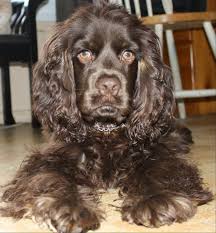
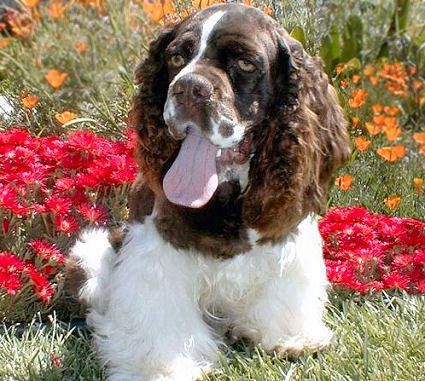
Meet the Cocker Spaniels!
Country of Origin: The Cocker Spaniel originates in England and was brought to North America in the 1800's.
Size: The Cocker Spaniel is 38-41 cm (15- 16.5 in) in shoulder height and weighs 8-13 kg (18-29 lbs). Cocker Spaniels have long, hanging ears and a round head with a square jaw. Their back is short and the body tightly framed. The Cocker Spaniel has straight front legs and the tail is typically docked.
Coat: The Cocker Spaniel has smooth hair of medium length. The hair should never be curly. The Cocker Spaniel coat may be a variety of colors: black, silver, cream, red, or brown, or a mix of another color with white. Non-black coats are known as ASCOB (Any Solid Color Other than Black). White, black, and cream coats are most common.
Character: Cocker Spaniels are intelligent, cheerful, lively and affectionate. They are very loyal to family, and love to play. The Cocker Spaniel is frequently merry and always ready to please. It makes a terrific pet and/or a fine hunting companion.
Temperament: Cocker Spaniels get along well with children and other dogs or household pets. They should be exposed to pets and children when young for maximum social potential. The Cocker Spaniel is very joyous and energetic, enjoying play. It sometimes likes to bark. The Cocker Spaniel requires plenty of attention, love, and devotion, and if it feels its not getting enough it will come looking.
Care: Cocker Spaniels must be brushed and combed thoroughly on a regular basis, preferably daily. Cocker Spaniels should be taken to a dog grooming professional two to four times a year to have excessive hair plucked by hand. The Cocker Spaniel is susceptible to ear infections, and sometimes eye infections. The ears should be cleaned frequently and regular eye exams are recommended. Cocker Spaniels have a lifespan of 10-12 years.
Training: The Cocker Spaniel is quite willing to learn, so training must be consistent but not overly firm. The Cocker Spaniel may be difficult to housebreak.
Activity: A Cocker Spaniel should be walked multiple times a day or be given playtime in a yard of sufficient size. Most Cocker Spaniels love to swim.
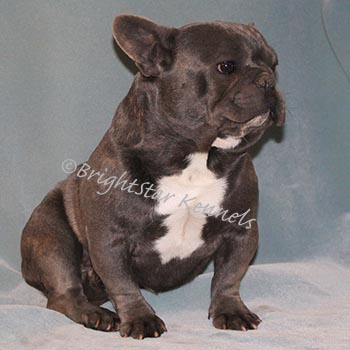

Meet the French Bulldog!
Country of Origin: The French Bulldog is a descendant of the English Bulldog. The French Bulldog was developed during the Industrial Revolution when workers, primarily lace makers, traveled from Britain to France, bringing smaller Bulldogs with them as companions.
Size: The French Bulldog has a shoulder height of up to 30 cm (12 in) and weighs 9-13 kg (19-28 lbs). It has a wide head, round ears, and distinctive pointed ‘bat ears’ with an attentive expression. French Bulldogs have short legs and tails, rounded chests, and compact, muscular bodies. Their unique shape gives them a low center of gravity and an odd stride. The French Bulldog has the appearance of an active, intelligent, muscular dog of heavy bone, smooth coat, compact build, and medium or small structure. Expression is alert, curious, and interested.
Coat: The French Bulldog has a moderately fine, brilliant coat which is short and smooth. It can be fawn, white, black, blue, or brindle, with a variety of markings which can result in a surprising diversity of appearances. The French Bulldog’s skin is soft and loose, especially at the head and shoulders, forming wrinkles.
Character: The French Bulldog is affectionate, uncomplicated, gentle, intelligent, sensitive, and fearless. The French Bulldog is known for its loyalty; its happy-go-lucky attitude is in sharp contrast to its sour face. French Bulldogs are happiest by their owner’s side and will misbehave if ignored. French Bulldogs are active, alert, and playful, but not unduly boisterous.
Temperament: French Bulldogs enjoy mixing with other dogs and household pets. They are great with children, well behaved, adaptable, comfortable companions with an affectionate nature and even disposition. Some French Bulldogs are cautious with strangers, but most are friendly to everyone. They are likely to drool or snore.
Care: When the French Bulldog is shedding, use a rubber brush to remove dead hairs. A special lotion will occasionally need to be applied to the facial and tail folds to keep them clean; soft tooth brushing with an approved toothpaste is also recommended. The French Bulldog has a lifespan of 8-12 years. Due to its facial features, it is susceptible to breathing problems and skin infections, and many are delivered via Caesarean section because of the large head. Most French Bulldogs cannot swim and are averse to hot weather.
Training: Consistency is important, but the French Bulldog is highly sensitive to the tone of its handler's voice, making training a fairly simple process. It is inquisitive and quick to learn simple tasks, yet unpredictable as it is a bit stubborn on occasion.
Activity: The exercise needs of the French Bulldog are uncomplicated, but it does require daily exercise. Sufficient rest is key to development of healthy bones, muscles, and joints—do not expect your French Bulldog to run long distances or jump down from tall ledges. French Bulldogs are well suited to apartment life.
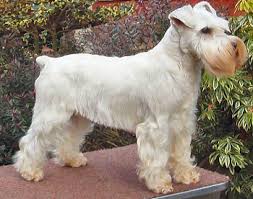
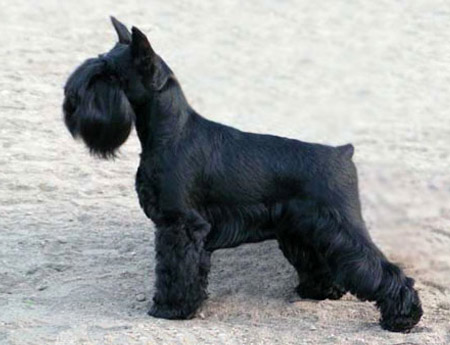
Meet the Miniature Schnauzers!
Country of Origin: Schnauzers (meaning ‘small beard’ in German) are named after an actual dog, ‘Schnauzer’ who lived in Germany in the 1870’s, but the breed itself existed as far back as the Middle Ages.
Size: The Miniature Schnauzer has a shoulder height between 12-14 inches and weighs between 10-15 lbs. The Miniature Schnauzer has a long, rectangular head with small, deep eyes and highly set ears which may be cropped or uncropped. Miniature Schnauzers have a flat back, highly set, erect tail, and small, round ‘cat feet’.
Coat: The Miniature Schnauzer has a soft, thick undercoat and a rugged, wiry outer coat which is solid black, liver, white or salt-and-pepper colored. The coat is longer on the chin and face, forming eyebrows and a beard. The Miniature Schnauzer sheds little.
Character: The Miniature Schnauzer is even-tempered and an eager, intelligent learner. It is brave and fun, making and an excellent companion. Miniature Schnauzers are loyal, protective, and alert, but do not make good guard dogs due to their size. At times, they may be pushy if they don’t know who’s boss.
Temperament: The Miniature Schnauzer gets along great with familiar children, dogs, and other pets, but it is wary and cautious with people and animals it does not know. Miniature Schnauzers are best behaved when given sufficient exercise and human companionship.
Care: The Miniature Schnauzer requires weekly combing and biannual grooming/shaping. Typically, pet Schnauzers are clipped and show dogs are stripped (dead hair is plucked via a serrated knife edge). Excessive hair around the pads of the feet should be removed and the ears must be kept clean. Miniature Schnauzers with cropped ears should be checked for ear infections. Miniature Schnauzers are prone to diabetes and pancreatitis. They should not be fed sweet foods, and should not be overfed to avoid obesity. Miniature Schnauzers have a long life span of 13-15 years or more.
Training: Though the Miniature Schnauzer learns fast, it has a slight stubborn streak. Training must be fair and consistent and should not be overly repetitious.
Activity: The Miniature Schnauzer has energy far exceeding its size and enjoys going for runs or playing games in the yard. It is well suited for apartment life.
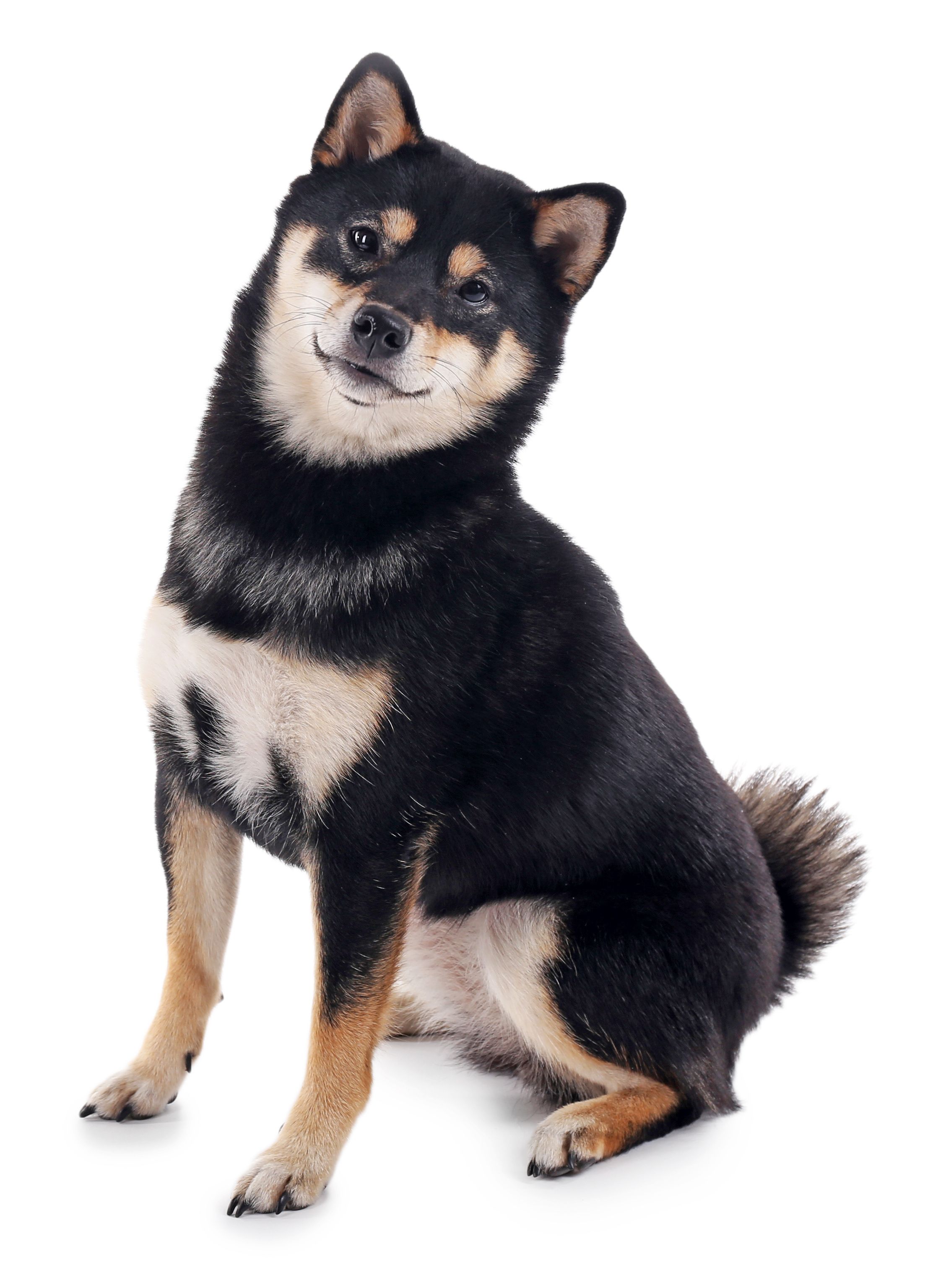
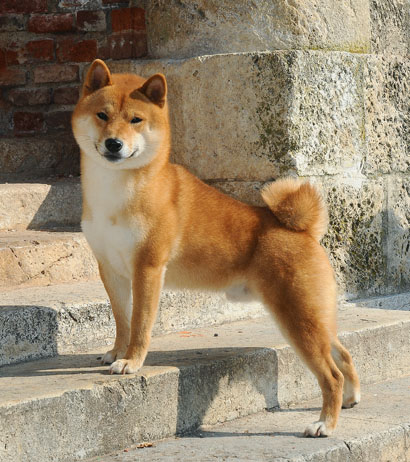
Meet the Shiba Inus!
Country of Origin: Japan.
Size: Height: 36.5 - 39.5 cm (14.25 - 15.5 inches); Weight: 18-30 pounds.
Coat: The Shiba Inu is double coated with the outer coat being stiff and straight and the undercoat soft and thick. Guard hairs stand off the body with the purpose of protecting the underlying skin and to repel rain or snow. The most common colors are red, red and white, white, black, black and tan, and salt-and-pepper.
Character: Shiba Inu's are curious, cheerful, and watchful. They bond closely with their owners. They are easily housebroken and bark infrequently.
Temperament: They are normally reserved around children and strangers but they normally get along well with all living things. They tend to exhibit an independent nature but do enjoy being a part of their family.
Care: Periodically remove dead hairs with a metal-toothed comb.
Training: It is best to make training seem like playtime, because this dog is very independent and thinks for itself. Shiba puppies can be relatively easy to housebreak and sometimes will train themselves.
Activity: This breed has remarkable stamina but will adapt itself to the exercise needs of its family.
Meet the Australian Cattle Dogs!
Country of Origin: The Australian Cattle Dog (also known as the ‘Queensland Heeler’, ‘Blue Heeler’, ‘Red Heeler’, or ‘Hall’s Heeler’) comes from Ireland—no, just kidding, Australia. When the wide open plains of Australia were opened for grazing in the early 19th century, the cattle were so active and unruly that the established lines of European herders weren’t up to the task. In 1840, a man named Thomas Hall crossed some blue merle Smooth Highland Collies with dingoes to create a breed known as the ‘Hall’s Heelers.’ These were crossed with the Bull Terrier in the 1870’s, making the breed more aggressive, and later with the Dalmatian for increased ‘carriage’ capability—the ability to run alongside horses. The Australian Cattle Dog’s distinct appearance and highly capable herding skills gained it notoriety across Australia. It was later imported to America and recognized by the American Kennel Club in 1980. An Australian Cattle Dog named Bluey lived from 1910 to 1939, giving it the Guinness World Record for longest canine life span.
Size: The Australian Cattle Dog has a shoulder height of 43-51 cm (17-20 in) and weighs 12-18 kg (25-50 lbs). It is a fast, strong breed with powerful muscles and a distinct appearance from its dingo heritage. The Australian Cattle Dog has a broad head with dark brown, oval eyes, small, pricked ears, and a scissors bite. It has a low set tail which curves in slightly between the legs and is docked only in American pets. The Australian Cattle Dog is slightly longer than it is tall.
Coat: The Australian Cattle Dog’s outer coat is weather resistant, short, and somewhat rough. The inner layer is short and thick. There are a variety of coat colors: red speckled (with possible dark markings on the head), or blue/blue mottled with possible markings of any color but black. Australian Cattle Dogs are born with a white coat which darkens increasingly over time. They shed once or twice a year.
Character: The Australian Cattle Dog is intelligent and willing to work. It is loyal and affectionate, and seldom barks. Bred to herd, Australian Cattle Dogs are very energetic and love to play. They can be stubborn and independent, but are highly obedient and attentive if properly exercised and socialized.
Temperament: The Australian Cattle Dog makes an ideal companion for children and other dogs if adequately socialized when young (though it may nip at running children due to its herding instinct). Australian Cattle Dogs are wary of strangers. They make good guard dogs if trained.
Care: The Australian Cattle Dog requires only occasional grooming with a brush or comb to remove dead hairs. Musculoskeletal and reproductive ailments are common areas of concern. The Australian Cattle Dog is comfortable in warm and cool weather, but prefers to live indoors. Australian Cattle Dogs have a life span of 11-13 years and litters of 4-8 puppies.
Training: The Australian Cattle Dog is highly intelligent, making the training process simple. It is willing and able to learn a wide variety of tricks, and sports such as catch or Frisbee. Australian Cattle Dogs must be kept occupied with tasks and provided companionship or they will become destructive and mischievous.
Activity: Constant exercise and activity are required to keep the Australian Cattle Dog happy. If you are unable to commit to this, this may not be the breed for you. The Australian Cattle Dog is definitely unsuited to apartment life.
Meet the Schipperkes!
Country of Origin: Belgium.
Size: Height: 10 - 13 inches; Weight: 12-18 pounds.
Coat: Abundant and dense, with longer hair on the neck, shoulders, chest and back of rear legs.
Character: Alert, loyal, and is insatiably inquisitive. The breed will impress you with its personable ways and unending energy.
Temperament: The breeds temperament shows it to be a positive dog, exhibiting very strong likes and dislikes, capable of making a decision about a situation. The breed is fond of children if properly socialized and supervised and frequently will attach itself to the children of the family, becoming their loving, loyal and watchful companion.
Care: Comb or brush the coat regularly with a firm bristle brush, dry shampoo when necessary..
Training: Training must begin early as he is intelligent, curious and stubborn and doesn't like to come when he is called.
Activity: Suited for city or country living. The breed does best with a fenced back yard and plenty of exercise.
Meet the Miniature Dachshunds!
Country of Origin: The Dachshund (pronounced dak-sund) originated in Germany in the sixteenth century. They were bred and trained to chase down prey, such as a badger or fox, enter its burrow, kill it, and retrieve it. The Dachshund was recognized as a distinct breed in 1910 and has gradually increased in popularity to become a favored pet.
Size: The Miniature Dachshund has a chest girth of 30-35 cm (11.75-13.75 in) and weighs up to 4 kg (9 lbs). All Dachshunds have an arched muzzle, almond shaped eyes, round ears, and straight tail. They are recognizable by their long, flat bodies and short legs. Writer H.L Mencken famously referred to them as ‘a half-dog high and a dog-and-a-half long’.
Coat: The Miniature Dachshund coat may be smooth, long, or wire-haired. All have distinct appearance. Colors can be reddish-brown, black, tan, chocolate brown, deep chestnut in reddish-brown, and black and tan. The hairs on the wire-haired Miniature Dachshund should lie flat and be as hard as possible.
Character: Miniature Dachshunds are energetic, brave, intelligent and independent. They are quite happy, even clownish, and can behave mischievously on occasion. The Miniature Dachshund greatly enjoys interacting with humans and is quite friendly and outgoing at home. Miniature Dachshunds make fine companions and are not typically used as hunters.
Temperament: The Miniature Dachshund is somewhat reserved around strangers and may bark at them, but forms a strong bond with family. It can be too courageous around larger dogs. Miniature Dachshunds are bold and outgoing, enjoying attention and frequently seeking adventure. They get along well with known children but may behave aggressively towards unknown children. Wired-haired Miniature Dachshunds tend to be livelier and more outgoing then smooth-hairs. Miniature Dachshunds are more reserved than the standard breed.
Care: The smooth- and long-haired Miniature Dachshund should be brushed occasionally to remove dead hairs. Long-haired Miniature Dachshunds are prone to tangles, so they should be groomed more often. The coat of the wire-haired Miniature Dachshund should be plucked twice a year. Miniature Dachshunds live 12-15 years.
Training: Long-haired Miniature Dachshunds are slightly easier to train than smooth- or wire-haired Miniature Dachshunds, however all varieties need firm and consistent training because they have minds of their own. The Miniature Dachshund is also sensitive and should be corrected gently, lest it become cowed and afraid.
Activity: The Miniature Dachshund needs a small amount of exercise; medium length walks or a fair amount of play in the yard should be sufficient. Miniature Dachshunds may tire easily so exercise should be spaced out throughout the day. Miniature Dachshunds can live comfortably in an apartment, but it is best if they get an occasional view of the wild. Frequent jumping and running should not be allowed as it may cause back problems.
